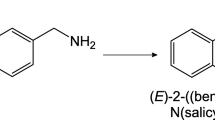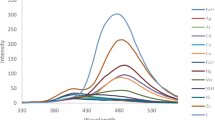Abstract
A simple and novel Schiff base chemosensor (BMHM) based on benzimidazole was synthesized. In ethanol–water (1:1, v/v) medium on varying concentrations of Zn2+ chemosensor exhibited a strong and quick turn on fluorescence response. The Zn2+ recognition was based on the Chelation–enhanced fluorescence effect. The binding constant and limit of detection for BMHM-Zn2+ complexation were estimated to be 7.99 × 104 M−1 and 0.148 µM, respectively. The extreme fluorescent enhancement caused by Zn2+ binding in chemosensor BMHM occurred at a pH range of 6–7. The practical use of chemosensor BMHM was tested by determination of Zn2+ in real water samples and comparing the results with the data obtained using high resolution inductively coupled plasma mass spectrometry.








Similar content being viewed by others
Data Availability
All data generated or analysed during this study are included in this published article [and its supplementary information files].
References
Prodi L, Montalti M, Zaccheroni N, Dolci LS (2005) Probes and Sensors for cations. In: Geddes CD, Lakowicz JR (eds) Topics in fluorescence spectroscopy, Advanced concepts in fluorescence sensing: Part A: Small molecule sensing. Springer Science and Business Media Inc., Boston, pp 1–57
Kwon N, Hu Y, Yoon J (2018) Fluorescent chemosensors for various analytes including reactive oxygen species, biothiol, metal ions, and toxic gases. ACS Omega 3:13731–13751. https://doi.org/10.1021/acsomega.8b01717
Katarivas Levy G, Goldman J, Aghion E (2017) The prospects of zinc as a structural material for biodegradable implants-a review paper. Metals 7:402. https://doi.org/10.3390/met7100402
WHO (1996) Guidelines for drinking-water quality. Volume 2: Health Criteria and other supporting information. 2nd edition. Geneva
Jiao S, Kong L, Liu G, Jia X, Tian J, Liu Y, Zhang L, Zhang W, Li Y, Huang Z (2020) A simple and an easy-to-synthesize turn-on fluorescent probe for rapid detection of Zn2+ and its application in bioimaging. Tetrahedron Lett 61:152507. https://doi.org/10.1016/j.tetlet.2020.152507
İnal EK (2020) A fluorescent chemosensor based on Schiff base for the determination of Zn2+, Cd2+ and Hg2+. J Fluoresc 30:891–900. https://doi.org/10.1007/s10895-020-02563-6
Gao LL, Li SP, Wang Y, Wu WN, Zhao XL, Li HJ, Xu ZH (2020) Quinoline-based hydrazone for colorimetric detection of Co2+ and fluorescence turn-on response of Zn2+. Spectrochim Acta A Mol Biomol Spectrosc 230:118025. https://doi.org/10.1016/j.saa.2020.118025
Kim S, Lee H, So H, Lee H, Kim KT, Kim C (2020) A benzyl carbazate-based fluorescent chemosensor for detecting Zn2+: application to zebrafish. Spectrochim Acta A Mol Biomol Spectrosc 228:117787. https://doi.org/10.1016/j.saa.2019.117787
Alici MK (2020) Phentroimidazole based fluorescence “turn on” sensor for highly sensitive detection of Zn2+ ions. J Fluoresc 30:269–273. https://doi.org/10.1007/s10895-020-02498-y
Zhao G, Guo B, Wei G, Guang S, Gu Z, Xu H (2019) A novel dual-channel Schiff base fluorescent chemo-sensor for Zn2+ and Ca2+ recognition: synthesis, mechanism and application. Dyes Pigm 170: 107614. https://doi.org/10.1016/j.dyepig.2019.107614
Ghorai P, Banerjee S, Nag D, Mukhopadhyay SK, Saha A (2019) Design and synthesis of a novel fluorescent-colorimetric chemosensor for selective detection of Zn(II) and Cu(II) ions with applications in live cell imaging and molecular logic gate. J Lumin 205:197–209. https://doi.org/10.1016/j.jlumin.2018.09.016
Das B, Jana A, Mahapatra AD, Chattopadhyay D, Dhara A, Mabhai S, Dey S (2019) Fluorescein derived Schiff base as fluorimetric zinc (II) sensor via turn on response and its application in live cell imaging. Spectrochim Acta A Mol Biomol Spectrosc 212:222–231. https://doi.org/10.1016/j.saa.2018.12.053
Gao W, Zhang Y, Li H, Pu S (2018) A multi-controllable selective fluorescent turn-on chemosensor for Al3+ and Zn2+ based on a new diarylethene with a 3-(4-methylphenyl)-1H-pyrazol-5-amine Schiff base group. Tetrahedron 74:6299–6309. https://doi.org/10.1016/j.tet.2018.09.017
Ergun E, Ergun Ü, İleri Ö, Küçükmüzevir MF (2018) An investigation of some Schiff base derivatives as chemosensors for Zn(II): the performance characteristics and potential applications. Spectrochim Acta A Mol Biomol Spectrosc 203:273–286. https://doi.org/10.1016/j.saa.2018.05.116
Fan L (2017) Synthesis of two coumarin-derived Schiff bases and investigation of theirs selectivity for Zn2+. J Fluoresc 27:1331–1337. https://doi.org/10.1007/s10895-017-2067-5
Kumar M, Kumar A, Singh MK, Sahu SK, John RP (2017) A novel benzidine based Schiff base turn-on fluorescent chemosensor for selective recognition of Zn2+. Sens Actuators B Chem 241:1218–1223. https://doi.org/10.1016/j.snb.2016.10.008
Mukherjee S, Talukder S (2016) A reversible luminescent quinoline based chemosensor for recognition of Zn2+ ions in aqueous methanol medium and its logic gate behavior. J Lumin 177:40–47. https://doi.org/10.1016/j.jlumin.2016.04.016
Hisaindee S, Zahid O, Meetani MA, Graham J (2012) Fluorescent studies of salicylaldehyde and other related carbonyl compounds for the selective and sensitive detection of Zinc(II) ions in aqueous solution. J Fluoresc 22:677–683. https://doi.org/10.1007/s10895-011-1003-3
Zheng ZP, Wei Q, Yin WX, Wan LT, Huang X, Yu Y, Cai YP (2015) Two Schiff base ligands for distinguishing ZnII/CdII sensing—effect of substituent on fluorescent sensing. RSC Adv 5:27682–27689. https://doi.org/10.1039/C5RA00987A
Wang W, Li R, Song T, Zhang C, Zhao Y (2016) Study on the fluorescent chemosensors based on a series of bis-Schiff bases for the detection of zinc(II). Spectrochim Acta A Mol Biomol Spectrosc 164:133–138. https://doi.org/10.1016/j.saa.2016.04.016
Horak E, Kassal P, Steinberg IM (2018) Benzimidazole as a structural unit in fluorescent chemical sensors: the hidden properties of a multifunctional heterocyclic scaffold. Supramol Chem 30:838–857. https://doi.org/10.1080/10610278.2017.1403607
Wei Y, Xu L, He S, Li C, Wu Q, Zeng X, Wang H, Liu K (2020) Novel benzimidazole-based conjugated polyelectrolytes: synthesis, solution photophysics and fluorescent sensing of metal ions. e-Polymers 20:16–31. https://doi.org/10.1515/epoly-2020-0003
Anbu S, Paul A, Surendranath K, Solaiman NS, Pombeiro AJL (2021) A benzimidazole-based new fluorogenic differential/sequential chemosensor for Cu2+, Zn2+, CN-, P2O74-, DNA, its live-cell imaging and pyrosequencing applications. Sens Actuators B Chem 337:129785. https://doi.org/10.1016/j.snb.2021.129785
Sumana GR, Bubblya SG, Gudennavara SB, Gayathrib V (2019) Benzimidazole and benzothiazole conjugated Schiff base as fluorescent sensors for Al3+ and Zn2+. J Photochem Photobiol A Chem 382:111947. https://doi.org/10.1016/j.jphotochem.2019.111947
Yun JY, Kim A, Hwang SM, Yun D, Lee H, Kim KT, Kim C (2019) A novel benzimidazole-based fluorescence probe for detecting zinc ion in aqueous solution and zebrafish. Bull Chem Soc Jpn 92:961–966. https://doi.org/10.1246/bcsj.20180390
Roy SB, Prodhan C, Chaudhuri K, Rajak KK (2017) A benzimidazole-based chemodosimeter for the fluorometric detection of Zn and Cu via 1,5 proton shifts and C-N bond cleavage. Photochem Photobiol Sci 16:1103–1116. https://doi.org/10.1039/c7pp00059f
Maji A, Pal S, Lohar S, Mukhopadhyay SK, Chattopadhyay P (2017) A new turn-on benzimidazole based greenish-yellow fluorescent sensor for Zn2+ ion at biological pH applicable in cell imaging. New J Chem 41:7583–7590. https://doi.org/10.1039/C7NJ01821E
Kim YS, Lee JJ, Lee SY, Jo TG, Kim C (2016) A highly sensitive benzimidazole-based chemosensor for the colorimetric detection of Fe(II) and Fe(III) and the fluorometric detection of Zn(II) in aqueous media. RSC Adv 6:61505. https://doi.org/10.1039/c6ra10086d
Velmurugan K, Raman A, Don D, Tang L, Easwaramoorthi S, Nandhakumar R (2015) Quinoline benzimidazole-conjugate for the highly selective detection of Zn(II) by dual colorimetric and fluorescent turn-on responses. RSC Adv 5:44463–44469. https://doi.org/10.1039/C5RA04523A
Kima MJ, Sharma H, Singh N, Jang DO (2013) L-cysteine recognition triggered by Zn2+ complexation with ligand. Inorg Chem Commun 36:96–99. https://doi.org/10.1016/j.inoche.2013.08.006
Galić N, Cimerman Z, Tomišić V (1997) Tautomeric and protonation equilibria of Schiff bases of salicylaldehyde with aminopyridines. Anal Chim Acta 343:135–143. https://doi.org/10.1016/S0003-2670(96)00586-7
Horaka E, Kassala P, Hranjecb M, Steinberg IM (2018) Benzimidazole functionalised Schiff bases: novel pH sensitive fluorescence turn-on chromoionophores for ion-selective optodes. Sens Actuators B-Chem 258:415–423. https://doi.org/10.1016/j.snb.2017.11.121
Skoog DA, Holler FJ, Crouch SR (2018) Principles of Instrumental Analysis. Molecular Spectroscopy, 7th edn. Cengage Learning, Boston, pp. 333
Formica M, Ambrosi G, Fusi V, Giorgi L, Arca M, Garau A, Pintus A, Lippolis V (2018) CdII/ZnII discrimination using 2,5-diphenyl[1,3,4]oxadiazole based fluorescent chemosensors. New J Chem 42:7869–7883. https://doi.org/10.1039/C8NJ00113H
Sil A, Maity A, Giri D, Patra SK (2016) A phenylene–vinylene terpyridine conjugate fluorescent probe for distinguishing Cd2+ from Zn2+ with high sensitivity and selectivity. Sens Actuators B-Chem 226:403–411. https://doi.org/10.1016/j.snb.2015.11.106
Singh H, Rajeshwari M, Khurana JM (2018) Synthesis, photophysical studies, and application of novel 2,7-bis((1-butyl-1H-1,2,3-triazol-4-yl)methoxy)naphthalene as a highly selective, reversible fluorescence chemosensor for detection Fe3+ ions. J Photochem Photobiol A 353:424–432. https://doi.org/10.1016/j.jphotochem.2017.12.003
Pandey R, Kumar A, Xu Q, Pandey DS (2020) Zinc(II), copper(II) and cadmium(II) complexes as fluorescent chemosensors for cations. Dalton Trans 49:542–568. https://doi.org/10.1039/C9DT03017D
Acknowledgements
The authors would like to acknowledge Düzce University.
Funding
This study was supported by Düzce University Scientific Research Projects Unit (Project numbers: 2017.05.03.620 and 2019.05.03.947).
Author information
Authors and Affiliations
Contributions
EO: Conceptualization, Investigation, Formal analysis, Resources, Writing—Review and Editing. EE: Conceptualization, Methodology, Validation, Investigation, Writing—Original Draft, Writing—Review and Editing. KŞ: Conceptualization, Investigation, Formal analysis, Resources, Writing—Review and Editing. ÜE: Conceptualization, Methodology, Investigation, Resources, Writing—Review and Editing.
Corresponding author
Ethics declarations
Ethics Approval
This article does not contain any studies with human or animal subjects.
Informed Consent
A statement regarding informed consent is not applicable.
Conflict of Interest
All authors declare no conflicts of interest to disclose.
Additional information
Publisher's Note
Springer Nature remains neutral with regard to jurisdictional claims in published maps and institutional affiliations.
Supplementary Information
Below is the link to the electronic supplementary material.
Rights and permissions
About this article
Cite this article
Orhan, E., Ergun, E., Şarkaya, K. et al. A Novel Benzimidazole-Based Chemosensor for Fluorometric Determination of Zinc Ions. J Fluoresc 31, 1833–1842 (2021). https://doi.org/10.1007/s10895-021-02818-w
Received:
Accepted:
Published:
Issue Date:
DOI: https://doi.org/10.1007/s10895-021-02818-w




